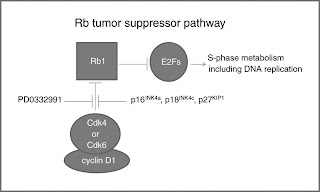Interesting thing about medicine is that knowledge never seems to end. It comes in waves as brilliant folk look upon failures and success with a critical eye and not through the lens of judgment. For both adding to success and learning from failure ultimately defines progress.
We have known about the cell cycle for quite a long time. Lets look upon the cell as it divides from one into two. Such division is required for the growth and well being of the human body. Cyclins are a very Important part of Cell Division and growth!
In short a Cell must go through the cycle of acquiring various agencies of proteins and enzymes before it can divide into two. Cells are in a continuous state of growth and replication. The stages move from G1 —> S —> G2 —> M and back to —>G1
(G1 = Initial state)
(S = Synthesis phase where the cell synthesizes various needed agencies within)
(G2 = Bulking up stage and acquired various agencies)
(M = Mitosis stage or the actual act of division)
There is a G0 cell phase which is interdependent on the G1 phase. G0 cells are quiet but functional, and not surging through the cell cycle. They can recruited into the cycle when need arises.
Chemotherapeutic drugs affect the cells cycle in various stages. eg. Vinca alkaloids and Taxanes in the M phase and the Alkylating agents in the G1 - S phase etc.
We shall focus on the G1 - S Phase inhibitors where most of the mischief seems to take place.
When an external mitogenic stimulus is received, in oncogenesis (tumorogenesis) at the G1 phase, the D1 Cyclins merge with the CDK4 and CDK6 to create a D:CDK4/CDK6 complex.
(D1 Cyclins + CDK4/CDK6 = D:CDK4/CDK6)
The D:CDK4/CDK6 complex phosphorylates the Retinoblastoma protein (pRb). pRb is a well known tumor suppressor. Thus phosphorylation of the pRb leads to its inactivation.
The pRb has the unique characteristics of sequestering the E2F family of transcription factors. This inactivation of the pRb leads to release of the E2F family of transcription factors that drive the wayward cancer cell from the G1 through to the S phase.
Although this might seem straightforward and simplistic, let us not forget that there are various Negative feedback loops available to protect us fragile humans. These are the INK family of p16 protein which is encoded by the CDKN2A gene and the CIP/KIP family of p21 and p27 proteins. Provocation by the TGF-beta signaling mechanism via the SMAD3/4 pathway, which leads to expression of the p16 and KIP family of p21 and 27 proteins that act as suppressors of the Cyclin D1 complex formation. Some of the initiators of these negative feedback loos are basic cell senescence and the release of various molecules that trigger the cell growth cessation
The "Ts" suggest blockade and Arrows mean throughput!
The magic being that p16 binds with the CDK4 and CDK6 and prevents them from creating the D:CDK4/CDK6 complex. This binding prevents the cell from going into the next phase of the cell cycle and ultimate division.
Most of the data on the Cycle Dependent Inhibitor activity was determined in Breast Cancer research where the Estrogen Receptor positive cases became resistant to the Anti-estrogenic compounds.
Several drugs have been manufactured as CDK inhibitors. The lead one is Pablociclib, that received FDA approval in Hormone positive Breast Cancer.
Pablociclib by itself was essentially useless as a therapeutic option. But in ER+, HER2- Breast cancer cases that had developed resistance to the antiestrogens, Pablociclib when given with Letrazole there was a substantially higher PFS of 26.1 months versus 7.5 months in (PALOMA-1 trial). PALOMA-2 trial (using Pablociclib + Fulvestrant) confirmed the PALOMA-1 trial data. The dose limiting toxicity, as one might expect, is based on the Neutropenia and Diarrhea. Both organs Bone marrow and the GI tract have fairly robust cell replication. The toxicity seems to have been addressed modestly well with another D:CDK4/CDK6 Inhibitor, Abemaciclib. And Abemaciclib crosses the blood-brain barrier to impact the brain metastatic disease as well. Corroborative data are not yet available on the brain metastatic activity at present.
Lest one thinks that these Inhibitors only work on Breast Cancer, you might not know that animal trials with mice suggest otherwise. Activity is noted in the laboratory in Melanoma, Colorectal Cancer and Non Small Cell Lung Cancer as well. Trials are or will shortly be in progress to prove efficacy in the various malignancies.
The problems that still need to be addressed are whether these “Ciclibs” can be used with chemotherapeutic agents, since both impact the cell cycle dynamics. And whether the combination might reduce the effects of one another. And equally whether they can be used with the Immune check-point Inhibitors (Anti PD-1 and PD-L1) since the growth and proliferation of the T Reg cells is dependent on the Cell Cycle also.
Time, Hard work and Good Basic plus Clinical Research will tell the tale.
Meantime, we have seem to have another arrow in our quiver.
Online References:
1. http://cancerdiscovery.aacrjournals.org/content/6/4/353.full
2. https://genomebiology.biomedcentral.com/articles/10.1186/gb4184
3. http://genesdev.cshlp.org/content/13/12/1501.full
4. http://ac.els-cdn.com/0092867495903852/1-s2.0-0092867495903852-main.pdf?_tid=0e3f1db2-5d7a-11e6-b269-00000aab0f6b&acdnat=1470669128_f251eeee9fd0e65f46702003f67c90e4






















No comments:
Post a Comment